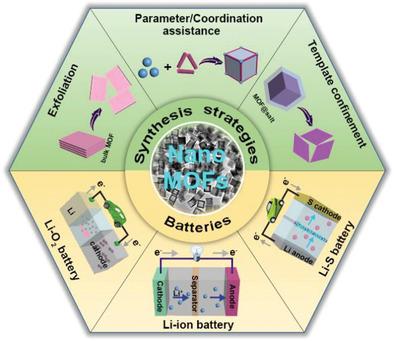Our official English website, www.x-mol.net, welcomes your feedback! (Note: you will need to create a separate account there.)
Recent Progress of Nanoscale Metal‐Organic Frameworks in Synthesis and Battery Applications
Advanced Science ( IF 15.1 ) Pub Date : 2020-12-31 , DOI: 10.1002/advs.202001980 Ming Zhong 1, 2 , Lingjun Kong 2 , Kun Zhao 1 , Ying-Hui Zhang 2 , Na Li 2 , Xian-He Bu 2
Advanced Science ( IF 15.1 ) Pub Date : 2020-12-31 , DOI: 10.1002/advs.202001980 Ming Zhong 1, 2 , Lingjun Kong 2 , Kun Zhao 1 , Ying-Hui Zhang 2 , Na Li 2 , Xian-He Bu 2
Affiliation

|
As one type of promising inorganic–organic hybrid crystal material, metal‐organic frameworks (MOFs) have attracted widespread attention in many potential fields, particularly in energy storage and conversion. Recently, effective strategies have been developed to construct uniform nanoscale MOFs (NMOFs), which not only retain inherent advantages of MOFs but also develop some improved superiorities, including shorter diffusion pathway for guest transportation and more accessible active sites for surface adsorption and reaction. Additonally, their nanometer size provides more opportunity for post‐functionalization and hybridization. In this review, recent progress on the preparation of NMOFs is summarized, primarily through bottom‐up strategies including reaction parameter‐ and coordination‐assisted synthesis, and top‐down strategies such as liquid exfoliation and salt‐template confinement. Additionally, recent applications of NMOFs in batteries as electrodes, separators, and electrolytes is discussed. Finally, some important issues concerning the fabrication and application are emphasized, which should be paid attention in future.
中文翻译:

纳米金属有机骨架材料的合成及电池应用最新进展
作为一种有前景的无机有机杂化晶体材料,金属有机框架(MOF)在许多潜在领域,特别是在能量存储和转换领域引起了广泛的关注。最近,人们开发了有效的策略来构建均匀的纳米级MOF(NMOF),它不仅保留了MOF的固有优势,而且还具有一些改进的优势,包括更短的客体传输扩散路径和更容易进行表面吸附和反应的活性位点。此外,它们的纳米尺寸为后功能化和杂交提供了更多机会。在这篇综述中,总结了 NMOF 制备的最新进展,主要通过自下而上的策略,包括反应参数和配位辅助合成,以及自上而下的策略,例如液体剥离和盐模板限制。此外,还讨论了 NMOF 在电池中作为电极、隔膜和电解质的最新应用。最后,强调了制备和应用中应注意的一些重要问题。
更新日期:2021-02-17
中文翻译:

纳米金属有机骨架材料的合成及电池应用最新进展
作为一种有前景的无机有机杂化晶体材料,金属有机框架(MOF)在许多潜在领域,特别是在能量存储和转换领域引起了广泛的关注。最近,人们开发了有效的策略来构建均匀的纳米级MOF(NMOF),它不仅保留了MOF的固有优势,而且还具有一些改进的优势,包括更短的客体传输扩散路径和更容易进行表面吸附和反应的活性位点。此外,它们的纳米尺寸为后功能化和杂交提供了更多机会。在这篇综述中,总结了 NMOF 制备的最新进展,主要通过自下而上的策略,包括反应参数和配位辅助合成,以及自上而下的策略,例如液体剥离和盐模板限制。此外,还讨论了 NMOF 在电池中作为电极、隔膜和电解质的最新应用。最后,强调了制备和应用中应注意的一些重要问题。



























 京公网安备 11010802027423号
京公网安备 11010802027423号